Copenhagen Art Festival, TRUST
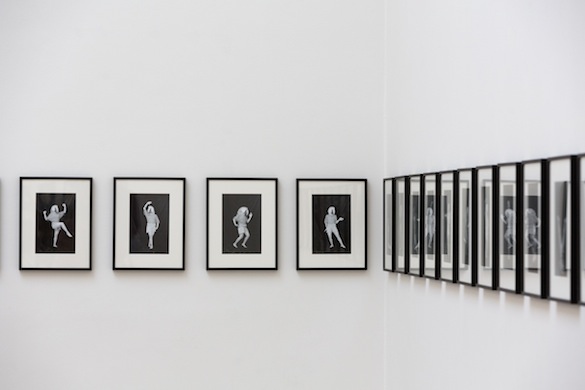
Interview with Sonia Dermience, curator, on the occasion of the Copenhagen Art Festival, 29.08_25.10. 2015
Let’s start with production: how did you choose the artists? How did you work with them?
I have already worked with most of the 43 artists. I work on long-term relationships. And in each show I add new ones! I build up a team maybe? A show is a summary and a starting point at the same time. I also invited a third of Danish artists after a research on the Copenhagen art scene: to anchor the exhibition in its context, to meet artists who will tell you about where you are, I created the context for these artists to propose a new piece or adapt an existing one.
Can we say that you see yourself as a kind of storyteller? What role does fiction play in your work?
The artists react to this context: the place, the story I tell myself and them. The context is real and fictious. It’s what you see and what you project on the architecture, the landscape, the history of the neighborhood, the building… The kunsthal is transformed into something else. It’s a white cube but it is also a castle, a factory, a shop, a temple… It depends from which angle you look at it.
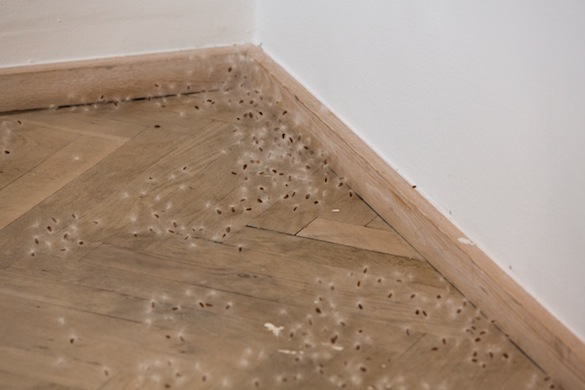
Atalay Yavuz ,Puff, seeds, 2014
How did you and the artists deal with the budget? I think it’s relevant to understand what are the results of re-negotiation between artists’ works and fundings available. (Especially if we think about Trust: trust between you and the artists, trust from the institutions, etc.)
We had to shrink the budget as usual so we all made an effort. We kept production budget for new works: between 7.000 and 10.000 Danish Crown for each artist and 20.000 for the three collectives who make The Temple, plus 5.000 Danish Crown for each artist as a participation fee and 10.000 for the collectives. My fee is 15.000 € plus costs.
It’s quiet equal and fair between the kunsthals, me and the artists. It’s also transparent. Artists who are more famous get the same as very emerging artists in many cases. Some artists receive more individually if they come from richer countries, they can receive grants for production or transport such as from Denmark, Switzerland, Norway and Sweden. Some other countries such as Belguim and France give for the travel of the artists. In the end, we put all the money together. There is a certain equity that can give a responsibility to deal with an amount of money and make it possible for all. Then the feeling of being part of something is very essential. It’s a bunch of artists, of colleagues who get together to create that fiction. It’s fast, it’s intense, it’s a reaction to a context, to an invitation. It’s a total TRUST. TRUST is also a serious joke: don’t trust me! Don’t trust the institution, the market, the art… It’s against the belief in anything. It’s a Yes and a No. It’s always a mixed feeling. It’s an invitation to be surprised. Making art is a jump in the unknown and it is what is scary and exciting at the same time and the audience, the public, the visitor have the same experience.
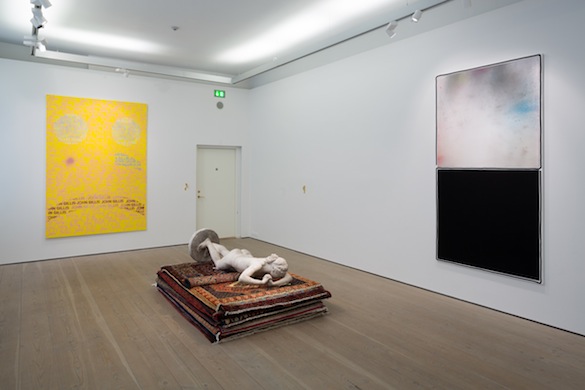
Jakup Auce, Our Comedies Are Nothing to Be Laughed At, painting on canvas, 2015; Nina Beier, Perfect Duty, loaned objects, 2015; Zin Taylor, painting on canvas, no title, 2015
There is the Palace: a new cabinet of curiosities. Speaking of which I would like to mention Jean Baudrillard, Umberto Eco, and Marcel Duchamp. First of all I would like to report some parts of Baudrillard’s discourse in his “The System of Collecting”1: “[…] all the objects that are possessed submit to the same abstractive operation and participate in a mutual relationship in so far as they each refer back to the subject, they thereby constitute themselves as a system, on the basis of which the subject seeks to piece together his world, his personal microcosm.” ; “The object thus emerge as the ideal mirror: for the images it reflects succeed one another while never contradicting one another. Moreover, it is ideal in that it reflects images not of what is real, but only of what is desirable. ” and “The collection is never really initiated in order to be completed […] What makes a collection trascend mere accumulation is not only the fact of its being culturally complex, but the fact of its incompleteness, the fact that it lacks something.”
Baudrillard also speaks later in this context about “temporal references that can be played at will”, which brings me to the next point: Umberto Eco’s semiotic notion of “encyclopedia” interpreted as a network of cultural units interconnected through mutual references. Notion that is very much related to what Marcel Duchamp says about art: “Art is a game between all people of all periods. ”
How does this encyclopedic view become evident in the Palace? How do the artists deal with references and with the idea of cabinet of curiosities? What do you think is new in collecting?
The concept of the collection in the Palace is very literal. It’s about collecting. It’s what rich people always did. Trying to possess the world. Then the middle class also started to gather objects. The artists can possess the world by their creation. Relating to their time and life. It’s the encyclopedia of the everyday, of the weird, of the hidden, the repressed. What is not obvious around us can be seen here from another angle with that capacity of classifying from everyday events to garbage to voices to film scenes to emotions to Internet quotes… The collecting and classifying by category of compeltely impossible collectible things. How do you represent the impossibility to interpret the totality in all its repetitions and its differences.
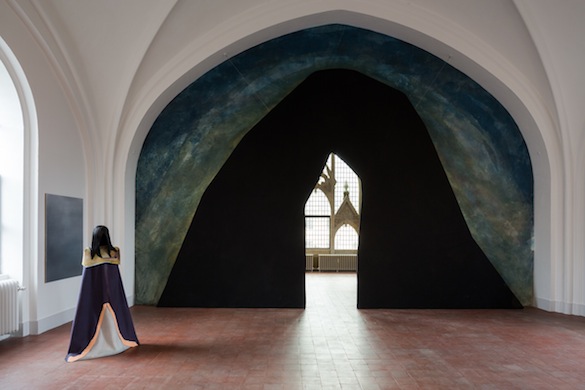
We Are The Painters, She Looks like A Mountain, in-situ installation, 2015
The Temple stands for a sort of mystical space, where artists explore topics such as consumption, contemplation and ceremonials. Sculptures and installations are what we see the most in this specific site. Can you say something more about it?
Yes, we had the idea a while ago to make a temple of art as a kind of pseudo Buddhist altar diguised into an exhibition. It was for the Belgian Pavilion in Venice and then we couldn’t make it because the artists we wanted to invite were not in the frame of what the Ministry of Culture was asking and we didn’t have the time to make the application. So the Temple was there and when I saw the church Nikolaj being an art center it was there! I saw the Temple… I called back Jessica Baxter. Then there is another floor to the church and a bell and we asked We Are The Painters to do something about bucolic contemplation and meditation for the first floor and A Kassen to do something about the sign of the church tower and bell. The three collectives complement each other in that comment on communal hobbies today, going to the museum like people used to go to church in the past is the first step into the fiction. Then the three projects: one about digesting the art, the other about looking at the epiphany of the creation of a picture and the third about the marking of time by the bell. The clock, the kitchen and the mountain. They are strong achetypes of how you structure society and how you free yourself from it. The look, the time and the ingestion. The Pizzeria that is invested by Torben Ribe is a perfect complement to this trilogy of free time.
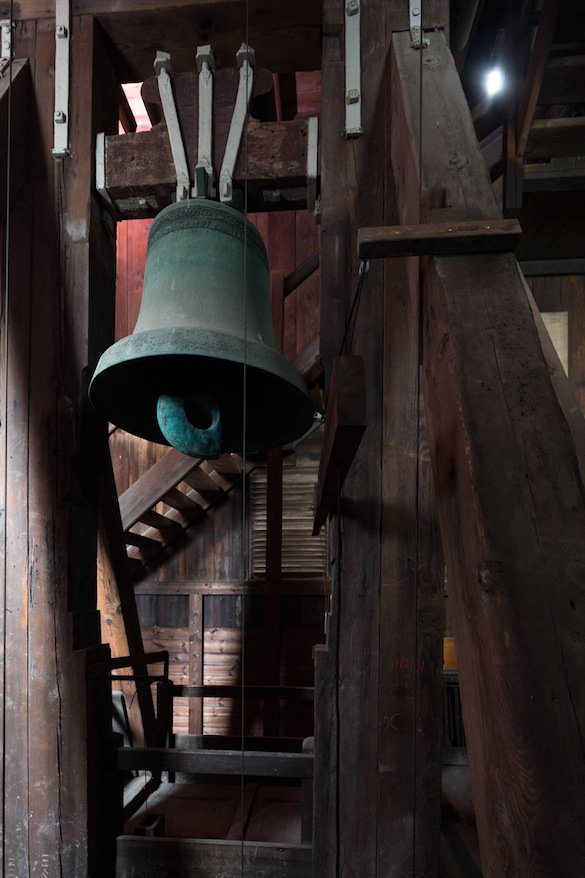
A Kassen, Sound of a Sculpture, in-situ installation, 2015
Is there a formal leitmotiv connecting the artists you chose? If so, how can formal recurring patterns impart new visions?
It’s often artists who work with transformation of symbols, material from the past, anecdotes… but without nostalgia or romanticism. There is either a lot of talk in some works or a lot of materials and colors! It’s excessive. It’s an overload of emotions. Artists who work on the limits or even more precisely considering there is none. You do too much, and it’s not enough. You don’t have to stop if you want more. They speak about excess and how to give an extra experience. It’s why my first title for the show was “extra-realism”, it’s about the reality plus an extravaganza layer or an extra-lucid layer. These artists anchor their practice in the social reality they exit to an extra world.
There are quite few works relating in some ways to the body, which brings us back to the idea of the subject as individual as well as part of a collective corpus. We can recall in this regard, Gilbert Simondon’s theory of individuation. I quote from Psychic and Collective Individuation: “The individual is neither a substantial being like an element nor a pure relation, but that it is the reality of a metastable relation.”2 We are thus talking about transindividuation as a category that subtends both psychic and collective individuations as a systemic unity. Do you find it is an urgent topic? Why?
Oh yes, I speak a lot about objects and so do I speak about subjects. Objects being the inert part of the life? Or considering objects are alive! The objects really make us. We are surrounded by them. We are in an object-oriented world. It’s all about acquiring objects. Giving them value, commercial, symbolic or visual… The qualities of the objects create the qualities of the humans. Or something like that. That you want to get rid of objecs or that you want more, it’s the same relation. The full and the void. It’s a double attraction for reassurance or clearing or risk. It’s why I think contemporary art is very interesting today as it speaks about our relation to images, objects, bodies, materiality or immateriality.
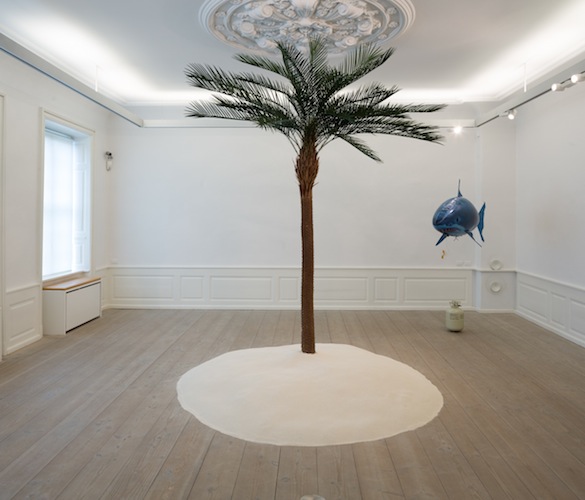
Mikkel Carl, No Woman Is an Island, installation, 2015
Negri says, in Arte e Multitudo, and I quote “The spectacle of the world is its endless reproduction. Here, when we are inside this movement, the collective and productive dimensions coincide.” What does it mean for you collective practice and how oes it relate to production?
We are never alone or always alone. What we do is more or less collective. Sometimes it results directly from interactions and sometimes from a communal decision and then it is signed by several people or under one name together. The idea of the band, the gang or the family was always part of my practice with a lot of returns toward individuality so that’s why I understand the fluctuation of collaborative practice in art. It’s both ways a liberation and a trap. So it’s great we can still do things in group, trio or duo. The influence and the dialogue are really creative and challenging. I don’t believe a collective questions more the authorship or the market, it’s just a very great way to create multi-forms and experiences.
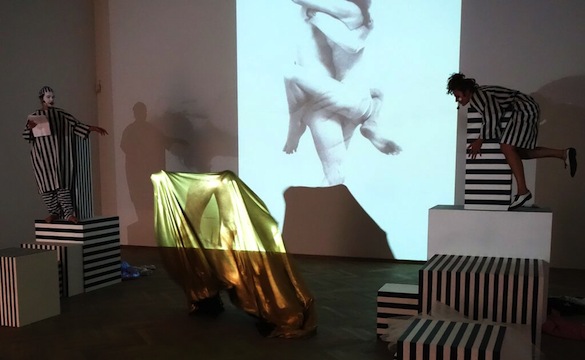
Angelo Plessas, Fantasy Plot Generator, performance and installation, courtesy The Breeder, Athens, 2011 and ongoing
Let’s talk about the Studio. Let me quote Geta Bratescu, who says: “The Studio is Myself.”3 (The importance of a working space relating to the self), and Gonzales Torres who, during an interview with Tim Rollins, says: “The reason why I don’t have a studio… I think that I’m very neurotic. Actually, I am neurotic. Having a studio would paralyze me completely. Just the idea that I would have a place where I had to go to work and make ‘something’ scares the shit out of me. The studio is a scary stage set.”4 On one side, the period of dictatorship in Romania, on the other, America in the 90s. What is the studio now?
The studio is the place where you create and it can be your head, a piece of paper, a computer, a room, a road, a train… The artists test the limits of the creative process. The overload of information then the void again. The artists also use works by others as source material like in the case of Adriana Lara who just sent a proposal to show boxes of other artists pieces but also pieces of others to speak about the inspiration that you can find in seeing other works. The museum can be the studio like in the past when the artists used to copy paintings in Le Louvre. The creation is a process of interpretation and appropriation. It’s something I like to work with in order to free creativity.
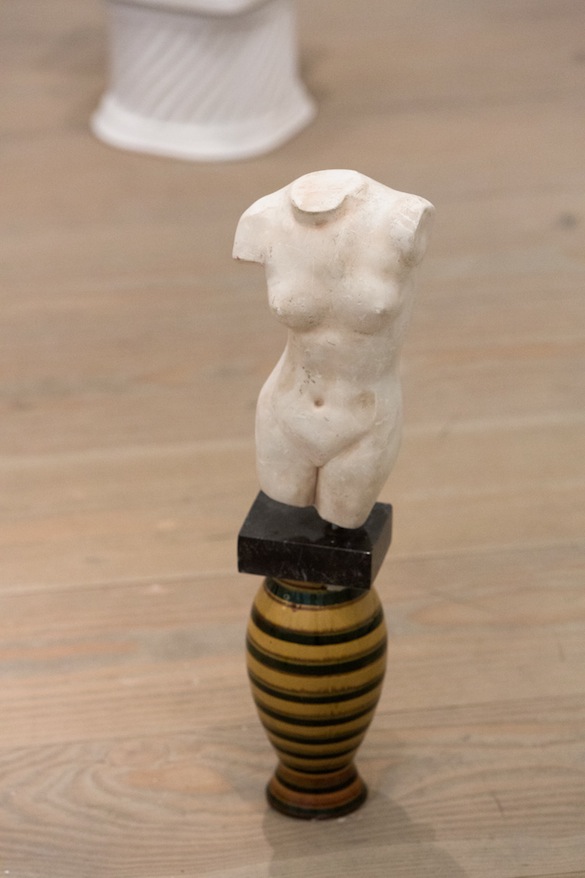
Seyran Kirmizitoprak, in-situ installation, 2015
Let’s talk a bit about architecture and decoration, and about fascination with history. Do you see archetypes as tools?
Yes, it’s a good approach. It’s a basis for the imagination. An archetype is like an example from the past that is still there today. The part of the exhibition that is called The Salon speaks about decoration but in fact all the artists of the show could have been in that section. It’s again about the relation to objects in our everday life. Their existence in ours. The sense they take as the decor of our lifes. The idea of decoration is a noble one, to decorate your life is to put ornament, to put a decorum, a layer of unecessary materiality. How the objects of use are designed as well. How they become obsolete and stylish. We are surrounded by things that have their own life, not only the plants and the stones. They have a power as well.
Some of the exhibition spaces are embedded in history (Palace), others in the vernacular (Pizzeria), others in the mythological (Temple). In your work as a curator are there actual borders between places and times or all things are equally considered?
It’s about that, reconsidering the status of those places. In a way, it’s to put the pizzeria at the same level as the kunsthal and the church and the studio… A kind of reversed institutional critique. They are our modern myths: the exchange, the market, the factory, the studio, the religion, places of production, sale, belief…
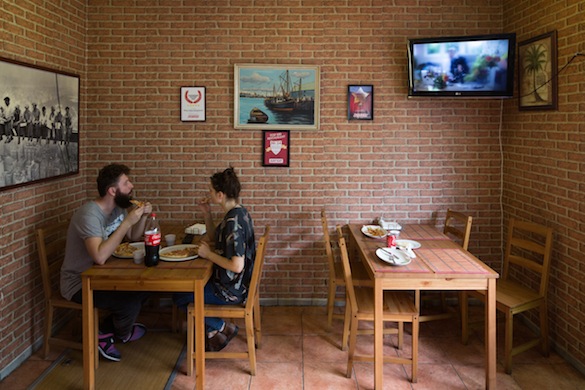
Torben Ribe, Untitled (Scrambled programme), video, 2015
1 Baudrillard, Jean, “The System of Collecting.” In Cultures of Collecting, edited by John Elsner, Roger Cardina, 7-24. London: Reaktion Books, 1994.
2 Scott, David. Gilbert Simondon’s Psychic and Collective Individuation. Edinburgh: Edinburgh University Press, 2014.
3 Brătescu, Geta, and Christophe Cherix.“‘The Studio is Myself’: Interview with Geta Brătescu.” Post. Notes on modern & Contemporary Art around the Globe. Accessed June 7, 2015. http://post.at.moma.org/content_items/23-the-studio-is-myself-interview-with-geta-bratescu
4 Cahan, Susan, Jan Avgikos and Tim Rollins. Felix Gonzalez-Torres. New York: ART Press, 1993.
articles liés
L’Attitude de la Pictures Generation de François Aubart
par Fiona Vilmer
Erwan Mahéo – la Sirène
par Patrice Joly
Helen Mirra
par Guillaume Lasserre

